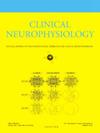Altered cortical plasticity but preserved cholinergic transmission in HIV-associated dementia: A TMS study
IF 3.6
3区 医学
Q1 CLINICAL NEUROLOGY
引用次数: 0
Abstract
Objective
We used transcranial magnetic stimulation (TMS) to examine whether short-latency afferent inhibition (SAI)—a marker of cholinergic transmission—and long-term potentiation (LTP)-like cortical plasticity via paired associative stimulation (PAS25) are affected in patients with HIV-associated dementia (HAD).
Methods
Seventeen HAD and 17 age-matched healthy controls (HCs) underwent SAI assessment; 15 subjects per group also completed PAS25. Resting motor threshold (RMT) and motor evoked potentials (MEPs) were recorded. SAI was measured as the ratio of conditioned to unconditioned MEPs, using peripheral stimulation followed by motor cortex TMS. PAS25 consisted of 180 paired peripheral–cortical stimuli at 0.2 Hz; MEPs were recorded at baseline, 0, 15, and 30 min (T0, T15, T30) post-intervention.
Results
RMT and SAI did not differ between HAD and HCs (RMT: 54.0 ± 7.8 vs. 50.7 ± 6.1; SAI: 46.9 ± 8.6 % vs. 44.9 ± 5.3 %). PAS25 significantly increased MEPs amplitude in HCs at all timepoints (RTEs: T0 = 0.76, T15 = 0.87, T30 = 0.80), but not in HAD (T0 = 0.31, T15 = 0.29, T30 = 0.26).
Conclusions
In HAD, cholinergic activity is preserved in motor cortex, while glutamate-dependent LTP-like plasticity is impaired.
Significance
SAI and PAS25 are complementary neurophysiological tools distinguishing HAD from Alzheimer’s disease.
一项经颅磁刺激研究:艾滋病毒相关痴呆患者大脑皮层可塑性改变但胆碱能传递保留
目的:我们使用经颅磁刺激(TMS)来检测hiv相关痴呆(HAD)患者的短潜伏期传入抑制(SAI) -胆碱能传递的标志-和通过配对联想刺激(PAS25)的长期增强(LTP)样皮质可塑性是否受到影响。方法对17例HAD患者和17例年龄匹配健康对照(hc)进行SAI评估;每组15名受试者也完成PAS25。记录静息运动阈值(RMT)和运动诱发电位(MEPs)。通过外周刺激和运动皮层经颅磁刺激,以条件与非条件mep的比值来测量SAI。PAS25包括180对0.2 Hz的外周-皮层刺激;在干预后的基线、0、15和30分钟(T0、T15、T30)记录mep。结果RMT和SAI在HAD和hc之间无差异(RMT: 54.0±7.8比50.7±6.1;SAI: 46.9±8.6%比44.9±5.3%)。PAS25显著增加了各时间点hc的MEPs振幅(rte: T0 = 0.76, T15 = 0.87, T30 = 0.80),但在HAD中没有(T0 = 0.31, T15 = 0.29, T30 = 0.26)。结论在HAD中,运动皮质胆碱能活性保留,而谷氨酸依赖的ltp样可塑性受损。意义:ai和PAS25是区分HAD与阿尔茨海默病的互补神经生理工具。
本文章由计算机程序翻译,如有差异,请以英文原文为准。
求助全文
约1分钟内获得全文
求助全文
来源期刊

Clinical Neurophysiology
医学-临床神经学
CiteScore
8.70
自引率
6.40%
发文量
932
审稿时长
59 days
期刊介绍:
As of January 1999, The journal Electroencephalography and Clinical Neurophysiology, and its two sections Electromyography and Motor Control and Evoked Potentials have amalgamated to become this journal - Clinical Neurophysiology.
Clinical Neurophysiology is the official journal of the International Federation of Clinical Neurophysiology, the Brazilian Society of Clinical Neurophysiology, the Czech Society of Clinical Neurophysiology, the Italian Clinical Neurophysiology Society and the International Society of Intraoperative Neurophysiology.The journal is dedicated to fostering research and disseminating information on all aspects of both normal and abnormal functioning of the nervous system. The key aim of the publication is to disseminate scholarly reports on the pathophysiology underlying diseases of the central and peripheral nervous system of human patients. Clinical trials that use neurophysiological measures to document change are encouraged, as are manuscripts reporting data on integrated neuroimaging of central nervous function including, but not limited to, functional MRI, MEG, EEG, PET and other neuroimaging modalities.
 求助内容:
求助内容: 应助结果提醒方式:
应助结果提醒方式:


